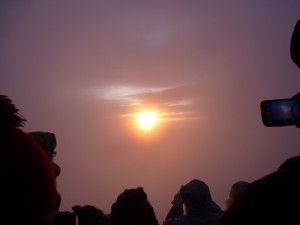Getting up to the top of Mt. Fuji was for me (John) a long and strange journey. 23 years ago I had been a California Youth Ambassador assigned to Japan. My job at the time was to promote California by going to different places in Japan. In the four months I was in Japan I went everywhere and everywhere I went was Mt. Fuji. On a clear day it dominates the Japanese skyline as it can be seen from almost anywhere on the main island and sometimes even on the smaller islands. As I traveled the land I saw Mt. Fuji over and over again. It seemed to call out to me and I remember starting to call it Fujisan (my friend Fuji). Even though I called Mt. Fuji my friend, it was a friend I didn’t really know and so I knew someday I would have to come back to visit.
Short Version:

On July 1st, AJ and myself (John) set out from Toyko to go and climb Mt. Fuji. Mt. Fuji is 3,776 meters high, which comes out to about 12,389 ft. tall (half the size of Mt. Everest). It took us 24 hrs. to reach the top from the 5th station (the tallest point you can get to by bus). Our goal was to see the sunrise from the top of Mt. Fuji, which we did on July 2nd, 2016.
Long Version:
Even though we trained for three months, we really didn’t know what we were getting ourselves into, even after summiting we weren’t quite sure what we had done. Despite that, looking into the rising sun struggling to break free from the clouds we knew instinctively that we had done something significant.
The beginning of our hike up to Mt. Fuji started at Shinjuku station in Tokyo. Transporting over 3 million passengers per day, Shinkjuku station is registered by Guinness World Records as the busiest transportation hub in the world. To give you a hint as to how big this station is, it has 51 railway lines that cross it. The bus station is on the 4th floor. It is amazing in itself to see how they drive these giant highway buses in some very tight corridors. It had already been a busy morning, since Denise and I had been to the Tsukiji fish market earlier in the morning. AJ and I arrived at the Shinjuku station at about 8 a.m. It took us awhile to find the right platform, but thanks to a tourist information center on the first floor we found our way to the bus ticket sales counter. I had prepared the day before by having the concierge service write down “I would like one adult and one child ticket to Mt. Fuji” on a piece of paper. I handed it to the sales lady and she responded “ie”, that means “no” in Japanese. At first I thought the paper was written wrong so I mustered my broken Japanese and muttered “Ni kippu kudasi Fuji”, which means “two ticket please Fuji”. Again “ie” but this time she handed me a timetable which clearly marked that all the bus tickets were sold. “Great!! All this way to be told I am idiot because I didn’t make a bus reservation.” I was told that there was a train that I could take but it would cost me double the amount of the bus and I wouldn’t get to the 5th station until 2 p.m. This was a problem. Starting a hike up Mt. Fuji at 2 p.m. would get us up to our mountain hut in the dark. Doable, yes, but not a fun way to start an epic hike. So while I tried to figure out what we were going to do, AJ decided he was going to do what he does best, twirl around like a mad man. I guess it worked because after a few minutes of him twirling a lady handed me a paper with the number 252 on it and said that if I came back at 9:52 a.m. I could try to get a cancellation ticket. I thought “what do I have to lose” so I took the number and we came back at 9:52 a.m. and to our surprise they called our number. We were very happy to get a seat on that bus. So happy that I made sure that I reserved and pre-paid for a 12 p.m. bus returning to Shinjuku station. I didn’t want to be stuck at the Mt. Fuji 5th Station without a return ticket.

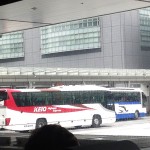






The bus trip was about 2 hours long. As we slowly headed into the interior of the country, things went from metropolitan to very green. At the base of Mt. Fuji are many different towns and villages. The side we were ascending from was from the Shizouka prefecture. The bus made a stop at the third station which is home to an amusement park known as Fuji-Q. From there we turned up a road called the Fuji Subaru Line. The Fuji Subaru Line is a road that is only open in the summer, which is the when Mt. Fuji is officially open for climbing.

The Mt. Fuji 5th Station, or as they translated it on the bus, the Mount Fuji Fifth Step, is kind of a weird preview for the hike that was about to come. That is to say, it didn’t represent at all the hike that was about to come. The Mt. Fuji 5th station is basically a tourist trap. It is like that part on Main Street USA at Disneyland where you walk through the shop just to find a door that opens right into another shop. There were hikers there, but there were also photo spots, horse rides, vending machines, and a very colorful shrine. They sold these souvenir walking sticks there as well. We had our own hiking sticks but bought a half a stick so that we could put it in my backpack and get branding stamps along the way. They also had ice cream at the 5th station. It was kind of hot when we got our hike started (at 12:30 p.m.) so we felt mountain berry (tasted just like strawberry to me) ice cream cones were the way to go.
The trail from the 5th station to the 6th station was kind of deceptive, in that it was very easy. It was a little bit steep in some places, but it was very well maintained, and it had lots of tree cover that offered nice shade. There were a lot of signs warning people not to go too fast and each sign had an estimated time of arrival to the next station along with the distance. There were also signs at the beginning telling people not to do a “bullet run”, go up and down the mountain in one day. The sign said we would get to the 6th station in a little over an hour which we did in about 40 minutes.
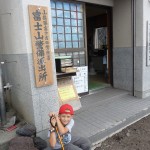


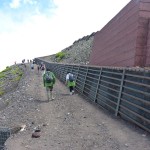
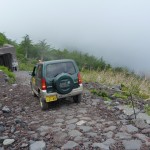
Getting to the 6th station we thought the hike was going to be a lot easier than we expected. We happily paid our 1,000 yen (about $10 USD) conservancy fee (completely optional, but who doesn’t want to protect the trails) and continued on our way. Right after we paid our conservancy fee, the trail changed dramatically. First of all, there were no longer any trees. Second of all, the dirt trail turned into a decomposed volcanic (Mt. Fuji is really a volcano not a mountain) rock trail. Then finally, we started to climb up the first of many steps on the trail. Despite this new development we pushed on.
About 200 meters (think two football fields) away from the 7th station we came upon two interesting things. The first thing we came upon was a television crew. At first we marveled at the fact that there was a television crew on top of Mt. Fuji and started to wonder what they were filming. Then they saw us and got really excited. We knew that July 1st was the first official hiking day of the 2016 Mt. Fuji season. What we didn’t know is several locals had reported to the ranger station a story about this little American boy attempting to climb Mt. Fuji. So, the local news station got a hold of the story and sent a crew to find this American boy. And so there, right at the cooled lava flow, which is the other different thing AJ spoke to a news crew. AJ was not at all shy, anyone who knows AJ knows that he will talk to pretty much anyone about anything. The news crew I think got a little more than they bargained for, not only did they learn that his name was “AJ” and that he was from California, but they also learned that he is “8 and a half years old and goes to Madison Elementary School” and that he “is strong and prepared for the hike because he does jogathon at school.” The news crew was a little bit confused about what a jogathon was but they smiled and thanked us for the interview. AJ was very excited about being interviewed and told everyone on the mountain how “famous” he was, which kind of turned out to be true, because pretty much all the hut owners and workers knew AJ’s name going up that mountain. Whether it was by word of mouth or because of that interview I can’t say for sure, but his fame did get him some privileges on that mountain.






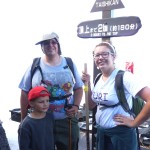
After leaving the news crew we started to climb up several lava flow formations. These lava flow formations were very rocky and pretty steep. Steep enough that to navigate them you needed to use both your hands and feet. No rope was required, but they did have guide ropes that showed you the way up the trail. Starting at the 7th station, we started to pass by a series of huts, which we used as rest stops. At the first 7th station hut we stopped and had our lunch, which was some 7/11 sandwiches that I had bought for the trip. At each hut there was a bathroom that you could use for 200 yen (about $2 USD) and different things for sale. The higher you went, the more expensive things got. While at one of the 7th station huts, AJ made a friend of a 15 yr. old girl from Winchester, CA. Winchester is very close to Riverside, CA, so those two had lots of things to talk about. AJ’s friend walked with us a long time on that trail.Which is good because it took AJ’s mind off the constant pace of the trail.
As we were almost to the 8th station my legs started cramping pretty bad. I don’t know if it was due to altitude or the length of the climb, but every time I had to scramble up a big rock my legs started to spasm. AJ was like a billy goat and loved the big rocks, but not me. Just as I was about to get to the first 8th station my legs seized up so bad that I slipped and fell on a stairway. It was so sudden that I barely had time to break the fall with my walking stick and arms. I fell on my behind really hard and it hurt even more. It took about 10 minutes of rubbing my thighs with my hands before I got my knees to bend again.



Needless to say, my climb from the 8th station to the 8.5 station where our hut was located was very painful. At the Mt. Fujisan Hotel, which is the biggest complex on the mountain, but still a hut and definitely not a hotel in my opinion, AJ’s friend left us. It was just me and AJ going up the mountain together to get to our hut. It was very painful climb and just before arriving I experienced another muscle spasm episode and literally crawled up the last set of stairs to the Goraikoukan hut.


I chose the Goraikoukan hut for two reasons. The first reason was that it was the highest hut you could stay overnight in on the mountain. This would give us the most amount of sleep time and yet have the opportunity to make it to the top of Mt. Fuji by sunrise. The second reason is that as part of their package they offered a hot dinner (it was about $150 for the both of us). There was a little confusion about our reservation, but I had my pre-paid reservation number with me. Also, the hut owner recognized AJ and decided it was big honor to have him staying at his hut so while we were at the hut AJ got to stay in the fire circle, which is something normally only the workers were allowed to do, but for AJ they made an exception. Our bed for the night was a futon mattress on a tatami mat. It wasn’t anything luxurious but after a full day of hiking it was all that we needed and I slept with no problems.
At 1:30 a.m. I could start to hear the movement of hikers and AJ told me that he needed to use the bathroom. I told him that once we left the hut, we could not come back and that we would have to start our hike up the mountain. He was OK with that so we got our stuff together, went to the bathroom, and started to hike up Mt. Fuji in the dead of night. I had packed two headlamps, but decided it would be better to have AJ use his headlight, put him in front of me and we would both be guided by his light. I had my headlamp on standby in case something happened to his. Right when got out of the hut we were faced with a big gust of wind that blew both of our hats off our head. We found my hat later in the morning, but AJ’s pokemon hat was never found.




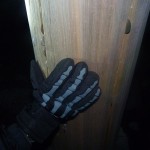



Going up in the middle of the night was slow progress. We were tired both physically and mentally, but there was nothing to do but to go up so we did. At the 9th station we found a 1 yen coin and decided to put it in the tori gate for good luck. I also saw what looked to be a memorial cross, a little reminder that you didn’t want to mess around too long at the top of Mt. Fuji or you could be next. At the 9th station we saw the stone guard dogs of Mt. Fuji that legend says protects Mt. Fuji by sending down wind, rain, and thunder. The legend says that they make sure that only those with real intent make it to the top of Mt. Fuji. We were tired, but at that point nothing was going to stop us from making it to the top.
The top of Mt. Fuji is marked by rocked carved shrine and a obelisk declaring the shrine the 10th station. We climbed a little more up to the crater and found another obelisk that we believe was marking the highest point in Japan. The top was very cold and windy. We were told that the weather was -23 C (-10 F). It was COLD! It was so windy that while at the crater I had to grab AJ because he kept blowing away. At the top there were some wooden pallet looking benches which we sat next to to wait for the sun to rise. It was very foggy and it looked like the sun, like us, was struggling to get through the clouds. We had wanted to get a branding stamp at the top of Mt. Fuji, but because of the wind and cold, all the structures (including the shrine) were closed. We took several foggy pictures and decided to start heading down the mountain.

The first part of the down hill climb was particularly slow because we had to use the up trail. Normally there is a different trail for climbing down Mt. Fuji as there is going up, but because of a mini avalanche a few days prior the first part of the downhill trail was inaccessible. We dodged all the uphill climbers and eventually got back to the 8th station where we were able to go down the downhill trail. The downhill trail is composed of crushed volcanic rock and is kind of slippery. It is also used by the hut workers to drive these little tread tractors up the mountain, which is how they get their supplies up and down Mt. Fuji.
The downhill was very long. After the 8th station there was no water stops and we ran out of water at the 6th station. AJ kind of lost it a little and cried just about 300 meters from the 5th station. I knew he was dehydrated, because I was as well, but I told him that there was nothing we could do about it until we got to the 5th station. It seemed like forever to get to that 5th station but we did. We finally got to the 5th station at 12:30 p.m., which means we were on that mountain for 24 hrs. It was a long time. So long in fact that we missed the 12 p.m. bus that I had pre-paid. Luckily, I had enough money and there was space on the 2 p.m. bus (it cost about $26 USD one way).

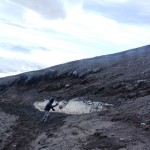




We got back to our hotel about 4:30 p.m. and you would think that after an adventure like that we would just crash in our beds, but that was not the case. We had just enough time to take a shower, get ready, and move on out because we had an appointment with the Robot Cafe for that evening, but that is another story all together.
Here is a little video of our thoughts while climbing:
